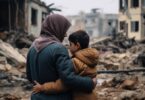For as long as humans have existed, they’ve helped each other. After emergencies like natural disasters or war, communities have collected and shared resources, often sending aid far away. This human impulse continues in the form of humanitarian aid. Today, “humanitarian aid” refers to logistical and material help in areas like food, shelter, education, and medicine. It’s often deployed to address immediate, short-term needs until institutions like the government can step in. Why is humanitarian aid important? Here are fifteen benefits:
#1. Humanitarian aid targets a variety of needs
The first benefit of humanitarian aid is how many issues it addresses. Explore any humanitarian organization’s website and you’ll get an idea of the areas they work in. As an example, Islamic Relief Worldwide, a faith-based agency with a presence in 40+ countries, deals with emergency response, health, education, food, water, livelihoods, and more. UNICEF, a UN agency focused on children’s rights, works on adolescent development, gender, health, climate change and the environment, and social policy. Rather than focusing on one or two concerns, the vast majority of humanitarian aid organizations use a comprehensive strategy.
#2: Humanitarian aid helps millions of people
According to the Global Humanitarian Overview 2022, the UN and its partner organizations reached 107 million people in 2021. This number represents those who benefited from at least one kind of aid, such as food or medical assistance. As an example, organizations reached 1.23 million people in northern Mozambique, which more than doubles the number of people served in 2020. Many more need assistance. While the reach in 2021 was impressive, the UN and partner organizations had hoped to serve 174 million. In 2022, the goal is to benefit 183 million people.
#3. Food assistance saves people from starvation and malnutrition
Hunger is linked to chronic diseases like heart disease, diabetes, and high blood pressure. It can also cause premature births, low birth weights, and stunted infant development. According to the Food Research & Action Center, food insecurity connects to the most common and expensive health problems in the United States. Food-focused humanitarian aid saves lives, improves health, and protects livelihoods. Looking at the Global Humanitarian Overview 2022 again, we can see the impact. According to the World Food Programme, almost 105 million people around the world received direct food aid in the first nine months of 2021. In South Sudan, over 500,000 “severely food insecure” people were helped. In Syria, almost 6 million people received regular food baskets.
#4. WASH services save lives and combat disease
WASH stands for water, sanitation, and hygiene. Without proper WASH, people are at severe risk for thirst-related issues and water-borne diseases. According to the CDC’s Global WASH Fast Facts, 2 billion people don’t have access to safe drinking water. Nearly half of the world’s population can’t access safely-managed sanitation, either. WASH-focused humanitarian aid helps. In 2021, half a million people in Iraq received access to WASH services, while in Venezuela, 1.8 million people got WASH help. UNICEF helped ensure that 34 million people got access to safe water for drinking, cooking, and hygiene.
#5. Medical humanitarian aid benefits millions
Medical supplies and training are essential in just about every emergency. The COVID-19 pandemic is a prime example, although diseases like malaria and Ebola have also been concerns for a long time. In 2021, UNFPA provided 2 million people with PPE in 29 countries. Through COVAX, 362 million doses of the Covid vaccine were shipped. Sexual health was also addressed; in 33 countries, kids and young people (aged 10-24) received tailored sexual and reproductive services. 29 million women of reproductive received sexual and reproductive health services, as well.
#6. Many people need shelter following emergencies
Disasters like floods, earthquakes, and hurricanes often destroy homes or force people to flee. Refugees traveling to new countries need shelter, as well. Most humanitarian organizations include shelter as one of their priority issues. As an example, the UN Refugee Agency distributes tents from three centers in Durban, Dubai, and Copenhagen. They also provide plastic sheeting and matting, as well as funds for rehabilitating communal shelters or building new homes.
#7. Humanitarian aid benefits children’s education
When disasters unfold, children are uniquely affected. Education is disrupted more often than not, which can have serious long-term consequences. UNICEF lists several issues, such as reduced earning potential, barriers to employment, and decreased participation in politics. People without adequate education are also more likely to experience negative health outcomes. While the gender gap in education is closing, girls are still more likely to have trouble getting an education. In 2021, UNICEF helped almost 110 million kids access formal or non-formal education. The UNHCR also connected over 869,900 refugee and host community kids with connected or home-based learning.
#8. Humanitarian aid benefits the most vulnerable
Women, children, and refugees are three of the world’s most vulnerable groups. Their vulnerability only increases in times of crisis. Luckily, humanitarian organizations focus on the people most impacted. According to the Global Humanitarian Overview 2022, 2.4 million malnourished kids were admitted for treatment. 5 million kids and guardians received mental health and psychological support. 11.3 million people got protection services, including legal aid and referrals to gender-based violence support. 4.2 million refugees and asylum-seekers got essential healthcare services.
#9. Humanitarian aid reaches affected areas fast
When an emergency strikes, recovery can take a long time. In the meanwhile, people need help immediately. One of the main benefits of humanitarian aid is how quickly it can be mobilized and deployed. According to UNCHR’s guide for emergency deployment, members of the international emergency roster need to be ready to deploy within 72 hours. UNDAC (the United Nations Disasters Assessment and Coordination) can deploy within 12-48 hours of a request.
#10. Humanitarian aid helps communities prepare
Humanitarian aid doesn’t only benefit people following an emergency; it can help them prepare for one. Many organizations, many of them local or national, hold various public trainings. Information includes how to prepare for an emergency (like a wildfire, earthquake, or hurricane), how to recognize the warning signs, and what to do. Humanitarian projects are also increasingly including preparedness as part of their own systems. This saves money, but most importantly, it can save lives.
#11. Humanitarian aid helps communities rebuild
The main goal of humanitarian aid is to save lives and reduce suffering. However, humanitarian aid’s role in community restoration also matters. If assistance only focuses on the short-term issues, it leaves communities in the lurch for the more challenging, long-term concerns. In a 2016 piece on the World Economic Forum, Habitat for Humanity CEO Jonathon T.M. Reckford writes: “Collectively, those of us offering humanitarian aid should leverage our efforts and precious resources to bridge the gap between relief and development so we can help families create permanent solutions to the challenges they face.” When the gap between short-term and long-term closes, humanitarian aid and development efforts empower communities to rebuild.
#12. Humanitarian aid is part of combating climate change
Climate change is a factor in many crises. According to the UN International Strategy for Disaster Reduction, storms, floods, and droughts have increased threefold over the last three decades. Because of population growth and urbanization, more people are affected by climate-related issues like reduced food security, unsafe water, increased migration, and disease. Humanitarian aid efforts must factor in climate change if they’re going to be effective. That necessitates more preparedness measures, more flexible cash assistance, programs, multi-risk management strategies, and so on.
#13. Humanitarian aid can help achieve the SDGs
The Sustainable Development Goals are a series of 17 interlinked global goals established in 2015 by the UN General Assembly. The deadline? 2030. If the world wants to meet these goals, humanitarian aid must become more innovative. In a post on the UNHCR Innovation Service, Dan McClure writes: “Reducing vulnerability and improving resilience needs to be seen as an essential component of humanitarian action.” A shift in how humanitarian aid is conceived could play a key role in achieving SDGs such as zero poverty, zero hunger, gender equality, and affordable and clean energy.
#14. Humanitarian aid gives people their dignity back
Humanitarian aid meets physical needs like hunger and thirst, but one of the main benefits of aid is how it gives people their dignity back. In the UNHCR Emergency Handbook, there’s a section on humanitarian principles. It describes humanitarian aid’s purpose as “to save lives and alleviate suffering in a manner that respects and restores personal dignity.” Helping someone in a way that disrespects their autonomy and dignity is not true humanitarianism. When properly given, humanitarian aid has a significantly positive effect on a person’s emotional and spiritual health as well as their physical health.
#15. Humanitarian aid can fuel hope and motivation
The humanitarian aid system is far from perfect, but despite its flaws and limitations, it can change the lives of those both receiving and giving assistance. It proves people and organizations are willing to help and sacrifice for others. It saves lives and eases the suffering of millions. In a time where crises are constantly erupting – and hope can be hard to come by – humanitarian aid can make dire situations a little brighter and motivate people to keep working for a better world.












